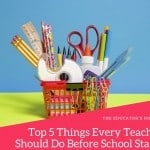Have you signed up for The Educator’s Room Daily Newsletter? Click here and support independent journalism!
This past Christmas, my family decided to organize our own version of the Great British Baking Show (or GBBS). We each had to make our own Signature dessert for the approval of three judges, my in-laws, and my oldest daughter. The winner would be crowned “Star Baker.” As I prepared my dessert, I worried it would not be pretty enough. I also knew the competition would be fun, and my dessert would highlight my flair regardless.
Sometimes when I plan a lesson or unit, I imagine my various administrators as a combination of the GBBS’s Paul Hollywood and Prue. Both judges expect their bakers to make amazing dishes from a variety of ingredients. In my case, when crafting engaging lessons, the curriculum is my recipe, and the extra special ingredients I add are student engagement and student choice. If I can incorporate these ingredients successfully, I win, and better yet, so do my students.
The Recipe (The Curriculum)
When I am cooking a new dish, I first look at the picture. Next, I read the ingredients and directions to make sure I have the necessary supplies and equipment to make my picture-perfect dish. I do the same in planning lessons. I begin with the final product in the forefront of my mind. I read the “recipe” to understand the expectations for student learning, such as “Students will draft an argumentative essay with a central thesis” or “Students will learn key vocabulary terms.” After reading the expectations, I decide what I can do to spice it up a bit.
Adding my personal flair has been my MO in teaching for the past 18 years as well. This is why I firmly believe teachers should look for ways to make lessons their own, even if it is scripted. Scripted curriculum is literally written like a skit:
Teacher: Today we are going to learn about…
Student: Be prepared for various answers.
When I was forced to use scripted curriculum, administrators would randomly pop in to make sure I stuck to the script. They never realized that I flipped it because my students were so fully engaged. For example, I took a bland vocabulary worksheet introducing text features and turned the definitions into QR codes. I sent students all around the school with iPads searching for the words matching the definition. Now, a scripted curriculum may have its place and be especially helpful for a first-year teacher or a substitute filling in. If I followed the script, it would be a recipe for disaster. Having a lesson with choice, engagement, and my secret ingredient is always at the forefront of my planning.
Spicing it Up (Student Choice and Engagement)
In GBBS, the judges set the product type, but each participant has a choice in how they incorporate those ingredients and choice of the final dish. My English department expects each classroom to complete the same final product for each unit of study. This is where I try to pull away as Star Baker and add something different. With the above-mentioned QR code scavenger hunt, I turned a plain vanilla experience into something more appetizing. As the unit progressed, I looked for unique ways for students to demonstrate their mastery. Ultimately, I asked students to create digital magazines on any topic of their choice. They loved using text features to teach about topics ranging from dirt bike racing to Harry Styles! As a result, they created something unique that truly made them shine.
Choice is vitally important for students as it produces creative and memorable end products. Students crave choice. Choice produces authentic and engaged learning. Choice also keeps me from becoming stale in my presentation of lessons. If you were baking an award-winning dish, would you use stale ingredients? Of course not! We need to use fresh ingredients in our teaching as well, and allowing students choice provides for that.
With the vocabulary lesson, I could have kept the original fill-in-the-blank document and let students copy definitions from a dictionary. How much fun would that be? How much energy would I spend redirecting off-task behavior? Instead, what my principal observed that day was students searching for codes in the hall, under desks, over the water fountain, and on my back while I constantly moved. My students had a blast and had all the notes for the new unit. Most baked goods all require a few eggs to bind the bake together. My go-to binding agent is fun. I want my students to have fun, and when I join in, it becomes a winning combo.
Give It a Go
Occasionally on GBBS, bakers will have their well-thought-out bake literally fall apart or not cook all the way through. Sometimes unexpected challenges happen, such as in one finale when a baker’s oven was not working properly. Similarly, even with our carefully planned lessons, we know things may go wrong. So we must monitor and adjust. I’ve not had a stone-cold oven, but spotty Wifi has caused issues on a number of occasions. I try to have a backup plan just in case.
Planning in this manner may not work for every teacher. But after 18 years of teaching, I know this method of tweaking the curriculum, addressing the expectations, creating an engaging experience, and providing student choice has served me well. It might be a bit out of your comfort zone, but take a chance and give it a go. I just encourage you to do what works best for you and for your students. No matter what curriculum you use, find your own unique flavor profile. So teachers – to paraphrase the words of the Great British Baking Show – gather your materials, your content, and… teach!
Editor’s Note: If you enjoyed this article, please become a Patreon supporter by clicking here.






